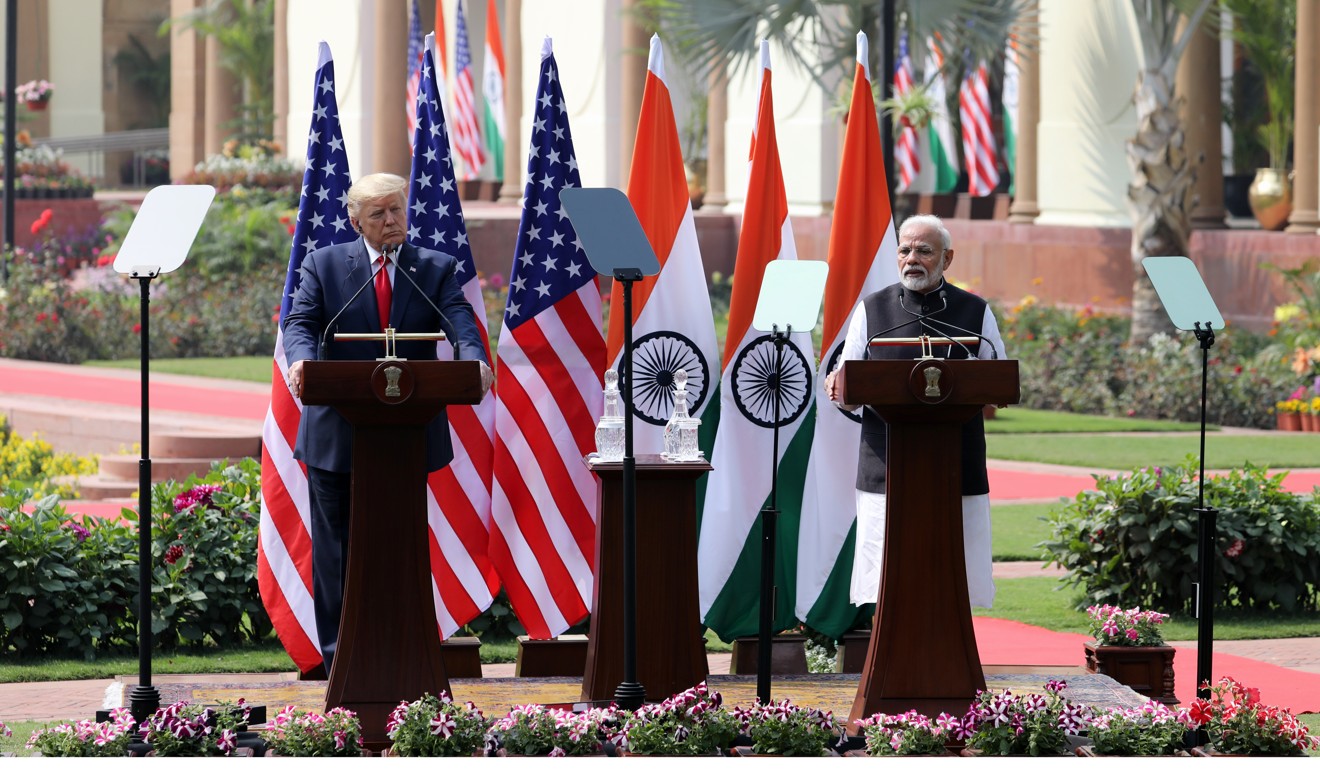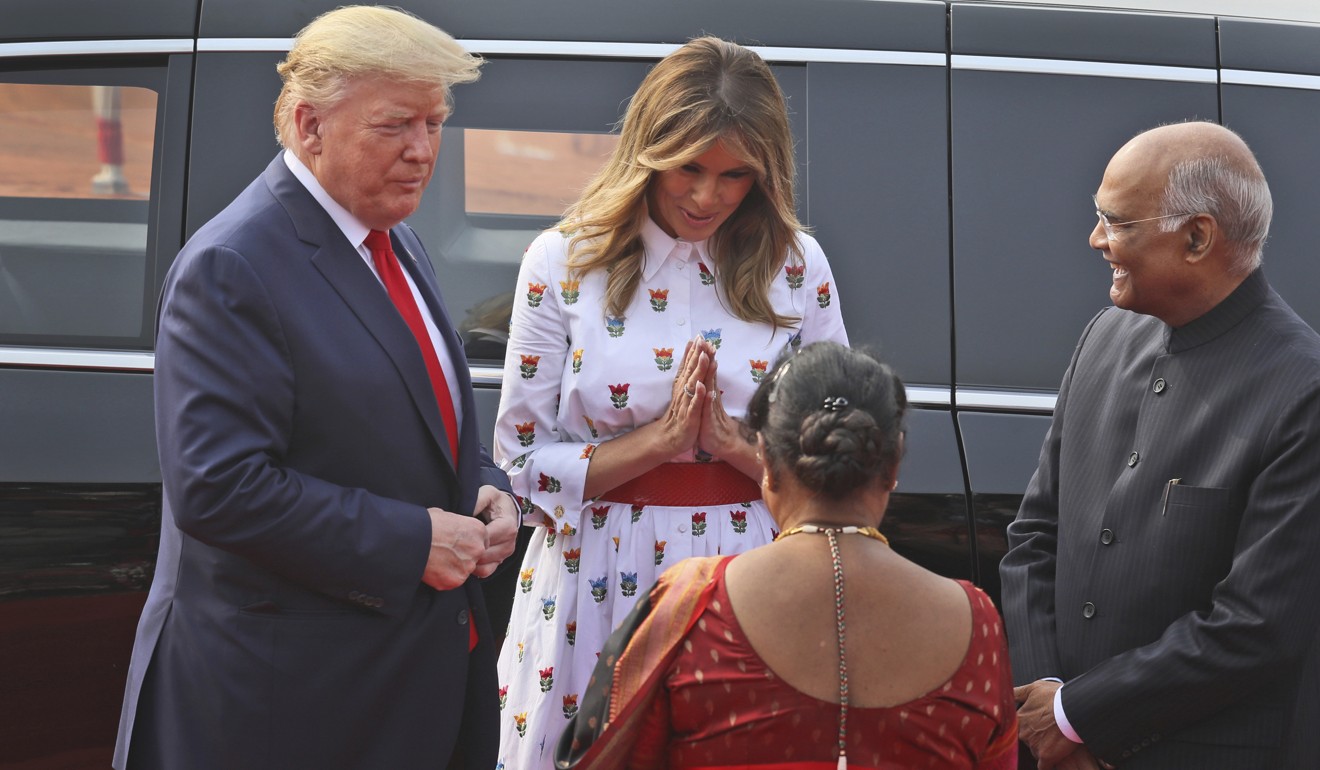
Trump and Modi discuss China factor, sign defence deal, but no trade breakthrough
- China’s expanding footprint in the Indo-Pacific as well as 5G networks formed part of talks between Donald Trump and Narendra Modi in New Delhi
- Trump’s visit has been overshadowed by violence over India’s controversial new citizenship law
The two leaders and their delegations met for over two hours on Tuesday morning, signing a US$3 billion military equipment sale to India and agreements on greater cooperation in sectors like defence, counterterrorism and geopolitical strategies, aimed at countering the expanding Chinese footprint in the region.
They also signed agreements on mental health and medical product safety, as well as a deal between Indian and American oil companies for building a liquefied natural gas network in India.

However, the two sides failed to make a breakthrough in the crucial, uneasy issue of trade that has led to frequent disputes between them throughout the Trump presidency. Both Trump and Modi said they had made progress in the talks, but the lack of a trade deal shows a conclusive outcome on the issue may evade the two countries.
“Our teams have made tremendous progress on a comprehensive trade agreement and I’m optimistic we can reach a deal that will be of great importance to both countries,” Trump said.
Trump, in his press statement, hinted at the American position on 5G networks in India. “We discussed the importance of a secure 5G wireless network & the need for this emerging technology to be a tool for freedom, progress, prosperity, not to do anything with where it could be even conceived as a conduit for suppression and censorship.”

In addition, Trump said the two leaders had discussed the Quad, a grouping of the US, Japan, Australia and India in the Indo-Pacific region, and hoped for deeper cooperation within the grouping.
Following up on his announcement, Trump said the United States had approved the sale of 24 MH-60 Seahawk Romeo helicopters for the Indian Navy along with six Apache helicopters for the Indian Army, worth over US$3 billion.
China ‘threat’ looms large as Namaste Trump meets Howdy Modi
The Indian side also discussed neighbouring Pakistan with the US delegation.
“We raised concerns around financial accountability, cross-border terrorism and narcotics [smuggling] in regard to Pakistan, and these concerns were placed on the discussion table,” said Indian foreign secretary, Harsh Shringla.
In what India will consider a victory for itself, Trump said India and the US were geared to fight the threat of terrorism.
“India and the US are committed to protecting its citizens from radical Islamic terrorism,” Trump said.

Both the leaders hailed the 36-hour visit as a success, with Trump calling it “unforgettable, extraordinary and productive”, and thanking the Indian people for the “exceptional generosity”. Modi said the two countries had decided to upgrade their ties to the comprehensive global strategic partnership level.
“Today we discussed every important aspect of US-India partnership, be it defence and security, energy strategic partnership, trade or people to people ties. The strengthening in defence ties between India and US is an important aspect of our partnership,” Modi said.
India pours on pageantry with raucous welcome for Donald Trump
Various Indian cities have seen massive protests over the last two months, since the Modi government approved changes to India’s citizenship laws which fast-track refugee status for non-Muslim communities from India’s Islamic neighbours, Pakistan, Bangladesh and Afghanistan. Protesters have called the laws discriminatory and fear it might result in the disenfranchisement of Muslims in India.

India’s home minister Amit Shah held urgent review meetings with police officials and political leaders in New Delhi in a bid to quell the violence. However, the violence continued on Tuesday afternoon, with media reports of journalists being attacked by mobs.
On the eve of Trump’s visit to India, a White House official had told reporters that the president was expected to raise the issue of religious freedom with Modi during their talks. While there was no mention of this in their joint statement, Trump is expected to address the media later on Tuesday, where he is likely to face questions on the issue by reporters.
Trump will be the guest at an official state banquet hosted by Indian President Ramnath Kovind on Tuesday evening, after which he and his delegation will fly back to the US.

